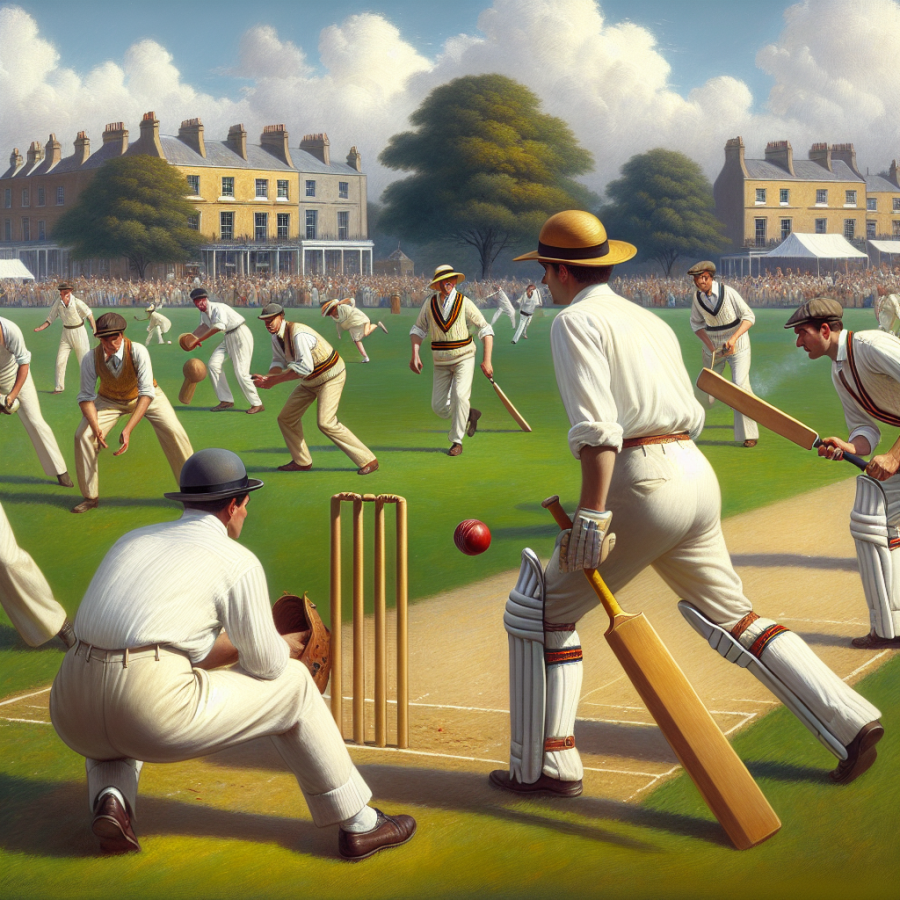Unveiling the Charm of French Cricket: An Unconventional Twist on a Classic Game
French cricket is not the sport that typically springs to mind when one thinks of cricket; it’s an informal, often impromptu version of the game that thrives on its simplicity and the element of fun. Unlike traditional cricket, French cricket doesn't require a vast playing field, intricate equipment, or elaborate rules, making it a perfect backyard sport.
One of the most intriguing aspects of French cricket is the position of the batter. Here, the batter stands with feet together, wielding the bat to protect not wickets but his or her legs, which serve as the target for the bowlers. This quirky feature means that the batsman's skill lies in the agility and ability to use the bat in a 360-degree range of motion, fending off incoming balls from any direction rather than mastering the art of shots on a neatly defined pitch.
The bowlers, on the other hand, must use guile and precision to hit the batter's legs below the knees. An exciting element of the bowler's role is that there is no set order or end from which to bowl; instead, players surround the batsman forming a somewhat predatory circle, eagerly waiting for their chance to throw the ball. Each participant can test their throwing skills from various angles and distances, but they must adhere to the rule of underarm bowling—a nod to the friendly nature of the game.
One of the most appealing quirks of French cricket is its flexibility in the number of players. It can be played among a small group of friends or can accommodate larger gatherings, adapting seamlessly to the number of participants. This versatility is a testament to its social nature and its role in fostering community and interaction among players of varying ages and skill levels.
Scoring in French cricket is another aspect that deviates from the norm. Since there are no running between the wickets, points can be assigned for successful hits by the batsman or for specific targets achieved by the bowlers. Alternatively, the game can simply progress without any formal scoring, with the pure joy of play taking precedence over competition.
It is also interesting to note how French cricket adapts to the players’ skill levels and the environment. In a more relaxed setting, players might agree on certain leniencies, such as allowing a one-hand, one-bounce catch to dismiss the batsman, or creating inventive, localized rules that contribute to the game’s distinctive character in different regions or circles.
French cricket might not be a term that is familiar to even the most ardent fans of traditional cricket, but to those who have experienced it, the game holds its own charm and idiosyncrasies. This casual version of the sport, often played in backyards and on beaches, appeals to a broad demographic precisely because of its quirky rules and informal setup.
The centerpiece of French cricket's unique appeal is its simplicity. Unlike traditional cricket, there are no wickets spread over a large field. Instead, the batsman's legs below the knee act as the wicket. Participants can use any form of bat-like object to hit the ball—often a tennis ball—which adds a level of resourcefulness to the game. This improvisational aspect not only allows for wide participation but also nurtures creativity among the players.
Accessibility and flexibility are key components of French cricket. The game requires no special equipment or an extensive playing area, making it an accessible sport for all ages and skill levels. Furthermore, it can be played with as few as two people, though it can also accommodate a larger group, allowing for the social aspect of the game to shine. The adaptability of the rules also means that it can be easily tweaked to suit the space available and the preferences of the players.
One of the idiosyncrasies of French cricket is the rule surrounding the 'batsman's stand'. The batsman must stand with feet rooted in one spot and is only allowed to pivot or swivel, rather than run between wickets. This encourages a different set of skills, focusing more on the adept handling of the bat and quick defensive moves. This immobility rule significantly changes the dynamic of the game when compared to traditional cricket.
Another quirky rule is that the fielding team can throw the ball from any direction towards the batsman. This leads to a degree of unpredictability and requires the batsman to remain alert and ready to defend from 360 degrees—quite a contrast to standard cricket where the ball's trajectory is more or less expected. It's these surprising throws that often bring laughter and amusement, reinforcing the game's status as a fun pastime.
Despite its informality, French cricket still values sportsmanship and the spirit of the game. This version of cricket, while fundamentally playful, does not compromise on the core principles that make cricket a gentleman's game.
Decoding the Rules and Customs of French Cricket: A Cultural Sporting Phenomenon
French cricket, despite its name, is neither French in origin nor a variation of cricket as the world widely knows it. This delightful and quirky yard game, actually rooted in British culture, is predominantly a children’s game that also enjoys popularity at social gatherings and picnics. It departs from the traditional game of cricket in several ways and is filled with its own set of rules and customs that make it a unique and engaging pastime.
The gameplay of French cricket is deceptively simple: participants use a cricket bat or any form of bat-like implement to defend a set of 'stumps', typically their legs from being hit by the ball. This game requires minimal equipment – a bat and a soft ball – and can be played in a variety of settings, unlike traditional cricket which needs a well-defined pitch.
One of the distinguishing features of French cricket is the player's stance. The 'batsman' must stand with their feet together, facing the 'bowler' with legs serving as the wicket. If the ball hits the batsman’s legs below the knees, they are considered 'out'. The role of the batsman rotates as players are eliminated, promoting a dynamic and inclusive playing experience where everyone gets a turn at batting.
The bowler's objective, however, may seem deceptively easy – to hit the batsman's legs – but the rules impose a twist here. They must throw underarm and the batsman is not allowed to move their feet. Nonetheless, the batsman can pivot or swivel to hit the ball away, making the role both challenging and fun.
A unique element to French cricket is the informal fielding arrangement. All other players take on the role of 'fielders', converging around the batsman. There are no fixed positions, which leads to a thrilling sport as fielders must constantly adjust their positions to catch the ball or field it after it is hit. This encourages a high level of alertness and responsiveness from all players.
In terms of scoring, French cricket differs significantly from the traditional game. There are usually no runs to be tallied; the emphasis is on survival and skillful defense. The 'runs' are metaphorical, clinging to the number of successful defenses the batsman has executed. It becomes a competition of endurance rather than a numerical scoring game.
'Modes of dismissal' in French cricket further illustrate its uniqueness.




